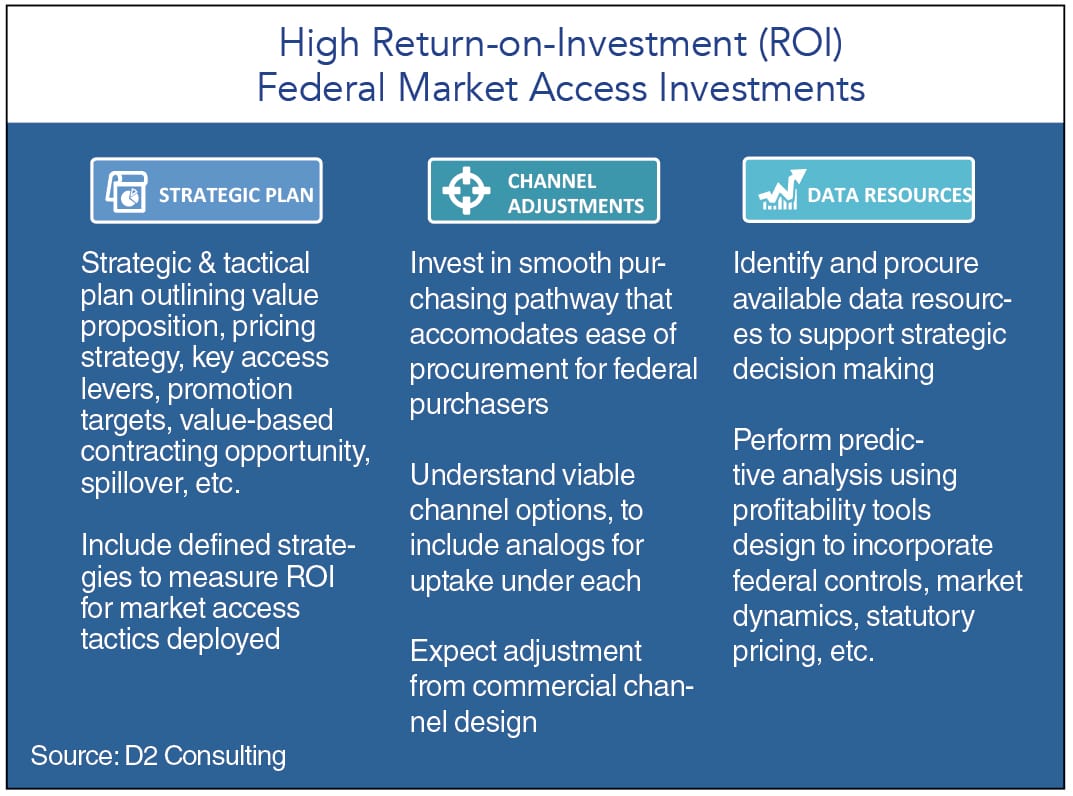The days of considering the federal segment a statutory liability with little value proposition to the overall commercial book of business are gone. The health systems managed by the Department of Veterans Affairs (VA) and Department of Defense (DoD) present tremendous direct revenue and indirect spillover opportunity.

Cheryl Nagowski
Federal payers are often cited as models for government and commercials plans resulting from their ability to purchase drugs at prices much lower than the rest of the market. As such, pharma companies have traditionally viewed these payers as being concerned with price over value, and many have failed to adequately invest in market optimization.
Although many are beginning to see the segment as one of strategic value rather than purely transactional in nature, it is often difficult to define key levers worth resource investment: Measuring the return-on-investment (ROI) is complex for federal market access activities. More progress is needed with regard to the availability of federal market data resources, which serves as the foundation for ROI determination.
If federal market access strategies are implemented post-launch, companies have the benefit of an established baseline with which to compare progress and measure ROI for tactics they implement. Ideally, however, companies will have made an up-front investment in federal opportunities and will need to rely upon analogs from management consultants who are experts in this space to determine which activities unique to federal will yield the highest ROI.
ROI Considerations in Pharma
Branded pharma companies invest significant resources in market access and have sophisticated means by which to measure ROI for those activities. The ROI on pull-through activities is measured by tracking prescribing behaviors. Co-pay card program effectiveness is measured by examining fulfillment rates on prescriptions for patients who receive this assistance versus those who don’t.
There are also complex tactics that offer both direct and indirect ROI. For example, the direct success of physician speaker programs used for peer-to-peer influence is measured by comparing the number of prescriptions written by physicians who have been exposed to representative speaker versus those who haven’t. Reasonable assumptions are then used to quantify the spillover related to exposure for the physicians attached to the prescribing physicians’ practice.

ROI in Federal
Since pharma companies manage multiple payer markets with increasingly smaller budgets, it is critical that investments yield meaningful ROI. Accessing federal beneficiaries requires navigating unique access limitations, and with already narrow profit margins, the cost of overcoming these challenges is often not attractive.
The real issue is that pharma companies often fail to understand how much they can control access in this segment. Strategic investments in developing advantageous pricing methodologies, implementing compliance with minimal disruption to commercial practices and targeted promotion can provide meaningful direct and indirect ROI.
Strategic Plan
One of the most beneficial steps in achieving a positive ROI in the federal sector is to establish a strategic plan. This plan should outline gross-to-net considerations unique to federal, ensure regulatory compliance, identify access levers the company can pull, define resources needed to support strategies and tactics, determine spillover opportunity, and establish means of measuring ROI on tactics deployed.
Developing a three-year plan will clarify market opportunity for internal pharma leadership, providing strategic confidence that often supports the allocation and prioritization of resources for federal.
Channel Adjustments
The federal government maintains a distribution channel program known as the Prime Vendor Program (PVP). Contract holders pay the federal government a negative distribution fee for all drugs purchased and routed through these wholesalers, and attempt to redeem that cost through fees charged in manufacturer agreements.
Operating as highly bureaucratic resource-constrained government agencies means deviations to standard processes are highly problematic.
The government is greatly incentivized to procure drug through its PVP, and has made the process to obtain drug outside of this channel exceedingly difficult. If a manufacturer ultimately makes the business decision to decline PVP participation, there is a clear pathway of government purchasing preference that should be considered in order to help minimize barriers to access.
Data Resources
The VA and DoD offer multiple direct data resources. Some can be purchased directly from the government, while others are obtained only when a supplemental rebate agreement is in place. While third-party vendors are not able to sell manufacturers federal claims data, they can sell analysis of that data, which is often beneficial.
Pharma companies should perform the same predictive analysis related to federal contracting decisions that they apply to the commercial market. In fact, many decide to procure profitability tools specifically developed for federal access analysis.
Cheryl Nagowski is senior director of federal markets at D2 Consulting.









